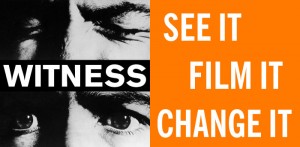Published September, 2014 by in Archiving Human Rights
Preserving Videos from Ferguson for Justice and Accountability
By Jackie Zammuto and Yvonne Ng
Photo Credit: Shawn Semmler/Flickr/CC BY 2.0/Ahd Photography/Flickr/CC BY-NC 2.0
As the war in Gaza and the protests in Ferguson, MO move out of the trending spotlight, many activists are shifting their focus from exposing abuses through images and videos to transforming these events into opportunities for dialogue and change. While this is a positive shift, it’s also important to consider how to best preserve videos documenting these alleged war crimes and police brutality so they may be further utilized as evidence in the fight for justice and accountability.
Of the thousands of videos being circulated from Gaza and Ferguson, it’s likely that only a fraction will be admissible in a courtroom, though many could be used for broader advocacy purposes such as campaign organizing or calling for an investigation. For example, it could be argued that the amount of coverage by local and national reporters, as well as the documentation captured by citizen witnesses, contributed greatly to US Attorney General Eric Holder announcing this week that the US Justice Department would launch a civil rights investigation into the Ferguson Police Department.

Video still from the International Committee of the Red Cross shows aid workers surveying conditions at the Al Aqsa hospital in Gaza following repeated attacks in the area.
While there is no magic formula for what constitutes an evidentiary video, there are some basic criteria, such as authenticity and context, that can strengthen the chances of a video being considered as evidence. For example, visual clues within the video (i.e. landmarks or street signs), along with the unaltered metadata, can help demonstrate the video’s authenticity and reinforce other sources for verification. Providing additional context, such as written documentation about the event depicted in the video can also be valuable.
Below are some basic tips that activists can take towards properly preserving the authenticity and context of human rights videos. To learn more about video preservation and archiving, check out the in-depth Activists’ Guide to Archiving Video (also available in Arabic and Spanish).
PRESERVING AUTHENTICITY
Keep a copy of the original file: If you plan to edit your video, it’s best to duplicate the file and work from the copied version. The original file should be kept in the same format that it was copied from the camera to the computer, without any processing or converting of the format. Edited or manipulated videos are less likely to be accepted in a legal setting because their authenticity is harder to verify. Be sure to keep the original file in a safe, but accessible place, such as an external hard drive (unless there are security issues). To avoid losing valuable content, consider investing in multiple external hard drives and storing the original files on one drive, plus a set of duplicate files on a different drive in a different location.

Think about long-term preservation.
Think about long-term preservation: Fighting for justice and accountability can take a long time. It’s important to consider the long-term value of your media and then assess your storage options. DO NOT rely on online services such as YouTube or Facebook to store your videos. These services maintain the right to remove your video if it does not comply with their Terms & Conditions. Additionally, when you upload videos to platforms like YouTube, a significant amount of the metadata is stripped from the file, making the video harder to authenticate. If you are live streaming, use a service that provides the option to download the live stream once you’ve finished filming. Don’t count on the site to preserve the session. If you’re interested in trying out some low-cost tools for organizing, archiving or storing your videos, check out this blog post for tips and recommendations. Read more about long-term preservation here.
PRESERVING CONTEXT
Create an information package: While videos can be good tools for documenting violations, they often lack contextual information around the event. Consider creating an “information package,” which is essentially a folder on your computer containing both the video and supporting documentation, such as a text documents providing details around the event, the name of the videographer, and names of the people interviewed or shown in the video. Read more about metadata and creating information packages >>
Organize your files wisely: Setting up and maintaining a clear folder structure for video files will help ensure that you, and others, can efficiently locate the files at a later date. For evidentiary purposes, it is important to keep video files in the order that they were recorded and grouped together by event and/or date. To make this easier, it’s best to maintain the original file name assigned by the camera. Rather than renaming files, organize the footage in folders or information packages that are clearly titled (i.e. date, brief context, location and name of filmer). Read more about filenaming>>

Raw camera footage in it’s original order.
Please share any additional tips or questions in the comments below!
Additional Archiving Resources
- Guide: Activists’ Guide to Archiving Video
- Interview on Democracy Now!: ‘After Police Abuses Caught on Video, a New Guide Teaches How to Best Archive and Distribute Footage’
- Online Discussion: Video as Evidence conversation with New Tactics, WITNESS + more
- Facebook Q&A: Live Video Archive Help

